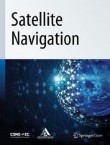Satellite Navigation is the official journal of the Aerospace Information Research Institute.
Orbit and clock products for quad-system satellites with undifferenced ambiguity fixing approach
Integer Ambiguity Resolution (IAR) can significantly improve the accuracy of GNSS Precise Orbit Determination (POD). Traditionally, the IAR in POD is achieved at the Double Differenced (DD) level. In this cont...

